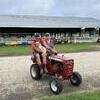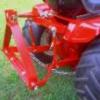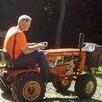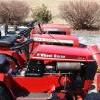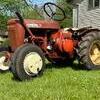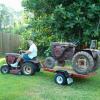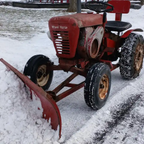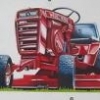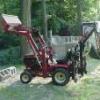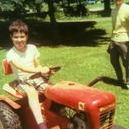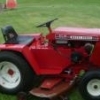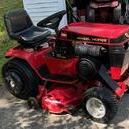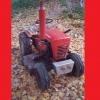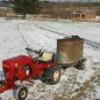Leaderboard
-
in all areas
- All areas
- Markers
- Marker Comments
- Marker Reviews
- Articles
- Article Comments
- Article Reviews
- Classfieds
- Classified Comments
- Classified Reviews
- Wiki's
- Wiki Comments
- Wiki Reviews
- Blog Entries
- Blog Comments
- Images
- Image Comments
- Image Reviews
- Albums
- Album Comments
- Album Reviews
- Files
- File Comments
- File Reviews
- Posts
-
Week
-
All time
November 28 2011 - January 19 2026
-
Year
January 19 2025 - January 19 2026
-
Month
December 19 2025 - January 19 2026
-
Week
January 12 2026 - January 19 2026
-
Today
January 19 2026
- Custom Date
-
All time
Popular Content
Showing content with the highest reputation since 01/12/2026 in all areas
-
19 pointsWanted to clean the new to me C-145auto but the garage was 28 degrees and it was even colder outside. So just a scraping, shop-vac and rag cleaning today. Also installed a belt engage/disengage lever (completely missing!)
-
15 pointsEarly birthday present for myself. Not perfect, but for the price I couldn’t resist.
-
13 points
-
13 pointsToday I took a portable train layout for an assisted living facility for show and tell. I had some pictures projected upon a screen of how I made some of the items and a video of my layout at home. Talked about how I got into trains (wife's uncle passed and left them to us). Answered questions how I made mountains, buildings and other items. I anticipated spending 30 minutes or so and ended up over an hour. The residents (some 20 of them) seemed to enjoy and appreciate The activities director asked who and where they rode trains. Interesting stories. Lots of laughter and memories for these folks. One funny part. I normally run my trains pretty slow--just looks more natural. Someone asked "will it go faster?" Another "Yeah, lets see it go fast." So I opened up the throttle and nearly all of them cheered! Not too bad for a 79 year old engine.
-
11 pointsActually done this yesterday but forgot to post it. Mounted new Deestones tri rib’s on 73 12hp-8 also new front wheel brgs., made up a short frame snow plow, put snow plow and bracket on 857. Took 1257 home and 857 to Moms and waited on snow that never came.
-
11 pointsI haven't named any of my tractors, even if I thought of a good name. Nothing against it at all. It's just that I can barely keep all my kid's names in my mind so I'm just trying not to confuse myself...
-
11 points
-
10 pointsI don't have a C-160 but I do have a C-120/180. If I subtract the 20 from the 80 does that make it a C-160.
-
10 pointsFirst look it reminded me of a belt keeper on er/guard for a early RJ ... thinking now a spring tooth. Tell ya what it really is ... a part to build an entire custom franken horse around... You start out with that one piece and end up with a running driving tractor.
-
10 pointsJanuary 15, 2009 The "Miracle on the Hudson" the emergency landing of US Airways Flight 1549 on the Hudson River on January 15, 2009, after a flock of geese disabled both engines shortly after takeoff. Thanks to the skill of Captain Chesley "Sully" Sullenberger and co-pilot Jeffrey Skiles, all 155 people on board survived.
-
10 pointsYesterday we brought home my grandpa's 1967 Cub Cadet 122 so I could tear into and replace a headgasket, reseal the motor, fix the clutch, fix some fatigue welds, go through the mower deck, get it all degreased, flush and refill tranny, and probably some other stuff that I cant think if off the top of my head. Anyways, I have been taking photos as I go along. And when we were taking it off the trailer the left front spindle broke so I'm in need of one of those.
-
9 pointsMore like insulation… gotta keep that hydro pump warm for best performance and long life !
-
9 pointsTook the C-145 for its first trail ride. Stuck and spinning more than moving along…back to the garage she went. Scored these used rubber tire chains at last summers WH Show and today they paid off! She went pretty much anywhere I wanted to go. Would have been unstoppable if I added wheel weights I bet!
-
9 points
-
9 pointsI just brought that 875 home a few hours ago. I even thought about going to look at the Electro as well. I'm pretty amazed that there are forum members everywhere. Not the first time I've seen posts about tractors I wanted to buy
-
8 pointsI put a winch on the dedicated snow machine. I hurt for 2 days anymore using the manual lift. I do about 3/8 mile of drives.
-
8 pointsPlastic scraper, flat blade screwdriver (being careful to not take the paint off), rags and elbow grease. No cleaning chemicals or even water. This spring I’ll remove the fender and guards and all and it’s get a proper pressure washing.
-
8 pointsDog and I hopped in the truck and took a little 700 mile jaunt to our Mo. location. Highlights along the way: Saw 2 white tail deer running along the edge of the woods next to the freeway just west of Lowell, Mi. Saw a flock of wild turkeys off in a field in northern Indiana. Saw a jack knifed westbound semi on the eastbound median shoulder with 2 heavy duty tow trucks working to get it loose Danced with the truck on ice a couple times on Michigan 6, just south of Grand Rapids - kind of in @Pullstart neighborhood. One of those dances was at 20mph - was really slick. No, I don't have 4 wheel drive - all those folks were in the fast lane flying by me. Was kind of hoping to see one of them get out of shape. Saw the aftermath of 2 rollover accidents - ice related. Pretty sure both were 4 wheel drive - didn't seem to help them. Remember folks, once a vehicle completely looses traction, physics takes over. You wiil move pretty much in a straight line from where you got loose. The faster you are going, the deeper into the puckerbrush you will end up. If there is a hill or birm involved, like both accidents I saw, rollovers can result. Bucked a headwind most of the 700 miles. That and the cold produced lousy gas mileage. Saw a guy who was flying along passing people on the right get pulled over by a State Policeman just west of St Louis. I smiled at that one. Enjoyed temperatures ranging from 9 to 20 degrees F. All in all, i'm happy to have arrived here safely.
-
8 pointsSo you basically removed all that paint protector! LOL Amazing how deep that stuff was. And BTW you missed a spot!
-
8 points
-
8 pointsTo my knowledge, no. What does matter is that you do not want the entrance of the wire going into the condenser pointing up. The wire acts like a wick when it rains; if the seal fails the condenser shorts out from the trapped water inside.
-
8 pointsSecurity camera footage of one of the more notorious and most wanted ringleaders:
-
8 pointsWell, we got around 6" or so of snow last night and it is snowing heavily right now. Another foot or so is forecast for today so I plowed some just to stay ahead of it. If I get too much then the big tractor and blower may need to come out. The 520HC is resting in the heated shop now. It is currently 9F with a wind chill of -2F so I wore my warm jacket and insulated pants to stay warm.
-
8 points
-
8 pointsI have an 875. First year for the "Wheel a Matic hydro which has slight differences with the later Hydrogear and Piston Piston models. The only more modern attachment that can work that I know of is the long frame snowplow if it has the extra hole to move the rear mount bar closer to the front.
-
8 pointsGot it apart, what you think? A little JP Weld might work. Got a cat scan done, confirmed, cam fubar.
-
8 pointsMy wife recorded me plowing snow on Dec 11 but I just got the video from her now to post it. The 520HC worked well as always.
-
8 pointsJanuary 12, 1966 "Batman", starring Adam West as Batman, Burt Ward as Robin, and Cesar Romero as The Joker, debuts on ABC.
-
8 pointsThat shouldn’t matter..you think you’re the only Eric? Or me the only Mike? Clyde is still my choice …. Now make it happen
-
7 pointsDon’t really need another tractor but I saw someone selling an 875 for $100 in my area. From what I can gather it’s a 1965 model year only, first automatic? I’m assuming none of the later attachments from the C series and 300 series fit. Just wondering if anyone has any input. Like I said, I definitely don’t need another tractor but for $100, it caught my eye.
-
7 pointsJanuary 17, 1984 Supreme Court rules (5-4) that private use of home VCRs to tape TV programs for later viewing does not violate federal copyright law.
-
7 pointsGot out this afternoon. There’s a loggging company working the woods so the trails are pretty much ruined and it’s tough to get around, also downed trees and limbs everywhere, but I still enjoy getting out.
-
7 points
-
7 pointsMystery boxes came today in a big truck: So I unpackered them: and now I am tired. The shop is more, or less, done for now. I still have some outlets to place, and an air line to run, but the major elements are in place. Time to get to work.
-
7 points
-
7 points'Course not to far off there EB. When I first succumbed to the addiction I had to look for them. Now they seem to fall out the sky. Some for free and many $100 rollers with a motor that fired right up. Some really nice ones for short money. People would see my junk yard and line ups from the road and just stop and see if I ran a tractor repair shop and ask if I was interested in another horse. She has since made me move them to unseen quarters Alice the C-120 came from a drive by for very very short money ... 200 ... ... with a magnum, a deck and a show tiller!!! Widowed PO just wanted to see it a good home.
-
7 pointsWhatsaa mattah wit' you... That's not metric & american. That's so you can use it on bolts that face each direction.
-
7 pointsOh, you would fit in this cab. I have not even started this tractor yet this season but I am keeping the battery charged so it's ready to go.
-
7 pointsStill lifting, still trying to be healthy. Tuesday, I received my 8 gallon pin donating blood. I donate often enough, that being on a regular schedule they say I am 1 day off of eligibility and have to wait until the next 8 week visit from the blood center. So it’s been 24 weeks now, but I’ll be back in another 16 weeks. Since I donate double reds, it takes twice as long for me to be able to donate. This morning, I lifted 360 lbs!
-
7 pointsFor $100 it would be in my shed by now. Worry about what fits and doesn't fit later.
-
7 points
-
7 pointsFront tach and hood pivot ready for assembly. Front tach lock assembly ready to install. Front tach lock and shaft partly inserted then E clip installed. Front tach lock spring slid onto shaft then shaft full inserted and E clip installed on opposite end from spring. Front tach lock slid over on shaft then the final E clip installed. Front tach lock release grip installed. Front tach latch assembly ready to install. Front tach latch pin has one E clip installed and is greased. Front tach latch pin slid into place and second E clip is installed. Latch shown in open position. Hood stop rod of my own design ready to install. I think Wheel Horse dropped the ball a bit on this design as the cotter pins get hit by the hood brackets. I use a solid 1/4" rod (you could use the original for this) slid into a piece of 3/8" tubing that has one hole drilled through to accept a cotter pin that holds everything together. Mine are all stainless steel but that is not required. Hood stop rod installed ready for cotter pin. Hood stop rod fully installed. Hood pivot assembly ready to install. There was some wear in the original rod and pivot brackets so I drilled the brackets and housing to 1/2" I then made up a 1/2" rod with holes drilled to accept cotter pins. Hood pivot shaft partly inserted and Right pivot bracket slid onto shaft. Hood pivot shaft partly inserted and both pivot brackets and washers slid onto shaft. Hood pivot shaft fully inserted and pivot brackets and washers slid into place on shaft. Hood pivot cotter pins installed. Front tach and hood pivot assembled. This is the tool I use to install the E clips.
-
7 pointsJanuary 13, 1888 The National Geographic Society is founded in Washington, D.C. for "the increase and diffusion of geographic knowledge"
-
7 points
-
7 points
-
7 pointsWe have been having some awesome sunrises and sunsets in Indiana too! But the moons the last three months have also been very bright and beautiful!
-
7 pointsthe left handle and the clutch pedal are on and add rubber pieces were your feet set next thing is getting the engine together and on the frame and the fenders and the pan painted gas tank mounted on the hood and both of them painted too a lot of work to go still
-
7 pointsI found a good trick for getting the gas out of a float. Seal the float in a container to keep the smell in and put it in a freezer for an hour or so. Remove it from the freezer, position the hole so that it is down, and heat the float up with an electric heat gun or hair drier. The temperature change will force the gas out of the float. It may take few cycles of this but it does work very well.
-
6 points
-
6 pointsLooks like a 78-79 C series going by the hood stand. But who knows, it’s been built with all sorts of parts. Worth $300? Nope
This leaderboard is set to New York/GMT-05:00
-
Newsletter

